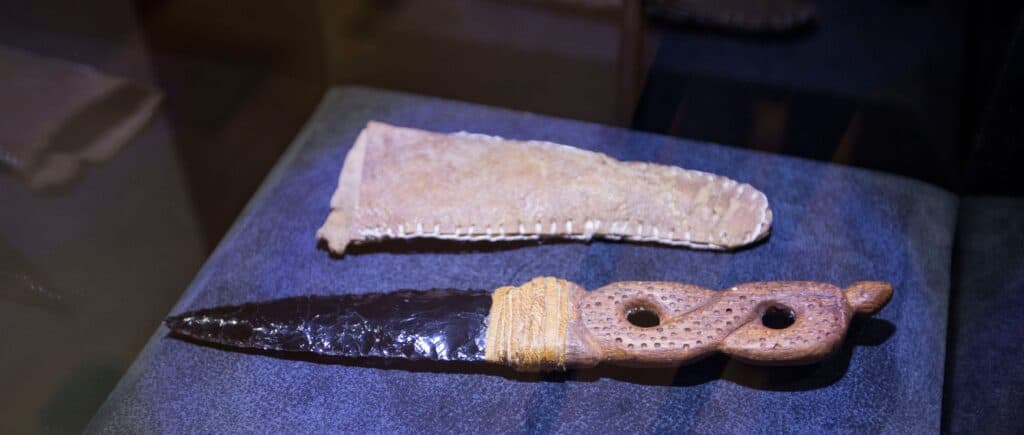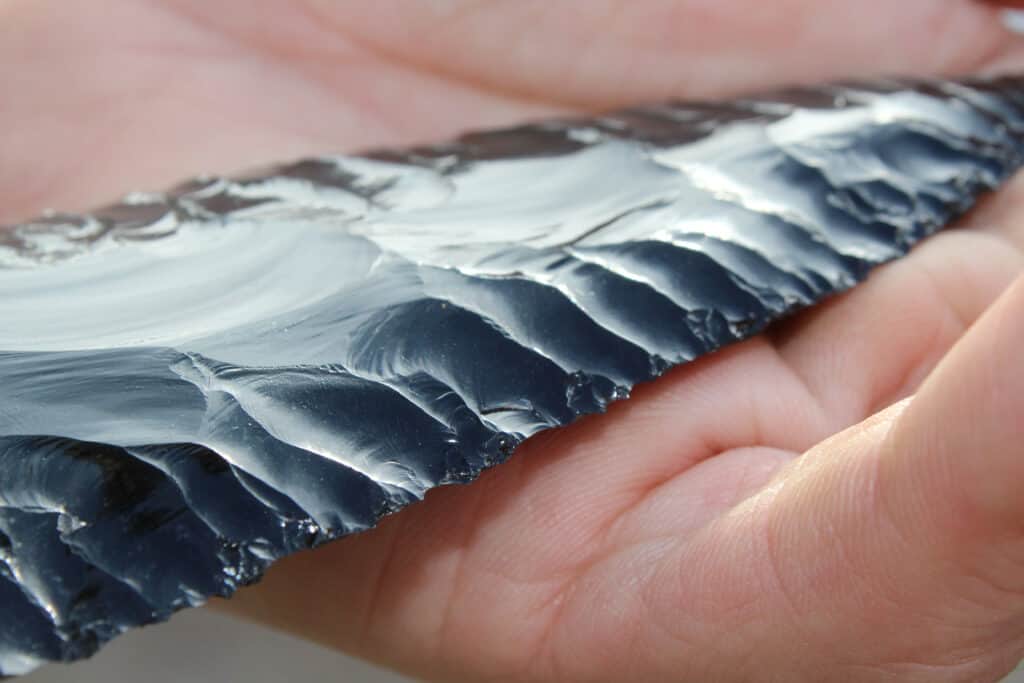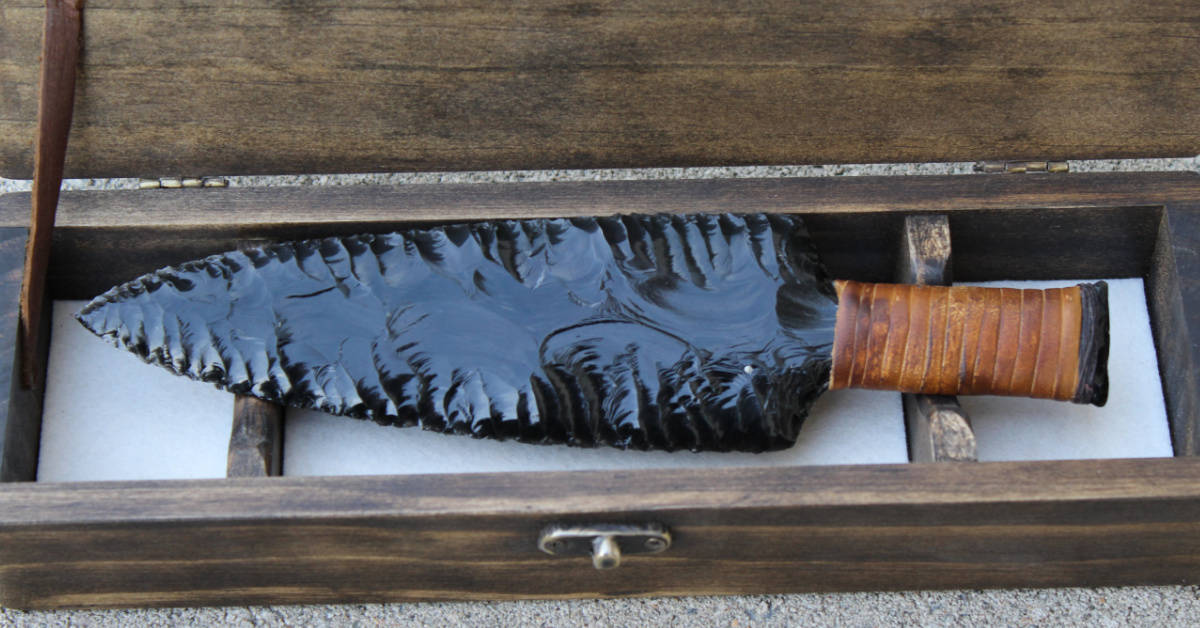As an Amazon Associate I earn from qualifying purchases.
One of my best memories as a kid is visiting family in Idaho every holiday. I’m sure the food was great, but the most exciting thing we did was look for obsidian pieces and arrowheads.
There was a site on my family’s land where we found dozens of 200+-year-old arrowheads that were still sharp enough to slice my fingers (ask me how I know…)
I recently had a bit of a romantic trip down memory lane and decided to start looking for a practical way to use obsidian. This led me down the road of obsidian knives.
Given how incredibly sharp and hard I thought obsidian was, it seemed like the perfect material. What I’ve learned is super cool but, I’ll admit, a little disappointing for those of us that wanted an obsidian pocket knife to carry.
Is Obsidian A Practical Blade Material?
Learning about the creation of obsidian and how it is formed into a knife sounds like something straight out of a fantasy book.
Obsidian is created when highly viscous lava is cooled rapidly. Because of the speed at which it cools, it does not have time to form a crystalline structure and, instead, forms a glass.
Like a ceramic or glass, this allows obsidian to form an extremely keen edge. However, it comes with all the drawbacks that you would expect.
The first major drawback is the work that’s required to form the super sharp edge. If you have an obsidian knife, you’re not going to be giving it a few strokes on a stone or in your strop to keep the edge.
Obsidian knives have to be sharpened through a process called knapping, which is essentially chipping away bits of the material until you have a sharp edge. Not practical for a carry knife.
The other major drawback is that, since obsidian is not formed under pressure like a diamond, it is not very hard or durable. This makes it unsuitable for most tasks where it will be exposed to impacts or hard use.
The thin edge of a truly sharp obsidian knife tends to be extremely brittle and can chip or break easily. This makes obsidian knives impractical for use in the kitchen, as carry knives, or in other daily tasks.
Obsidian knives in modern times are mainly used as display pieces or in traditional tasks such as animal skinning.
So, in short, obsidian knives do have a place and may have potential in the future but, no, you should not expect to be carrying an obsidian pocket knife anytime soon.
Just How Sharp Is An Obsidian Knife?
To put it bluntly, obsidian knives are very, very sharp.
The cutting edge of a blade can be measured in angstroms which gives you a rough idea of how sharp the knife is. To give you a point of reference, most household razor blades that are made out of steel measure between 300 and 600 angstroms.
An obsidian blade can hold an edge of just 30 angstroms, making it sharper than any modern scalpel.
In fact, despite a lack of FDA approval, some surgeons routinely use obsidian scalpels as they have some significant advantages over their steel counterparts. For instance, because of how sharp they can be, obsidian scalpels cause much less trauma to the flesh that they slice through, resulting in faster healing.
However, the brittleness of the blade means that there is a possibility that they could chip or crack during surgery, making it unlikely that they will ever see widespread use in modern medicine.
Are Obsidian Knives Durable?
Because obsidian lacks the crystalline structure found in conventional blade materials (such as steel…) it is not a very tough or durable knife material.
While it’s obviously incredibly sharp (or has the ability to be) the blade is more reminiscent of actual glass or ceramic rather than steel.
Obsidian’s brittleness makes it prone to chipping or breaking, rendering it ill-suited for tasks where it may encounter impact or hard use. So while modern obsidian knives are a great conversation starter, practicality isn’t their strong suit.
How Are Obsidian Knives Used?
Historically
Most people think of Native Americans’ use of obsidian arrowheads and knives when we consider the historical use of the material. However, there have been obsidian spearheads found that pre-date what we thought was the evolution period of homo sapiens.

As early as 365,000 years ago somebody was methodically chipping chunks of obsidian into knives and spear points.
In those early days, it is likely that they mostly served the function of daily tools and weapons as they were among the easiest materials to form an edge on and didn’t require any form of blacksmithing or heat.
However, to emphasize the utility and ability of obsidian knives it wasn’t just skinning animals and poking enemies that they were used for. During the Neolithic Period, obsidian knives were regularly used as part of surgery to open people’s skulls. While the same surgery is still performed it is no longer done with obsidian knives and we know it’s to relieve pressure and not release evil spirits.
Where Can I Buy A Modern Obsidian Knife?
Finding obsidian knives for sale isn’t that much of a trick. However, where you buy an obsidian knife is highly dependent on what you plan on doing with it. If your desire is simply a display knife and a cool conversation piece, many stores sell obsidian knives with bone handles that fit the purpose.
For every other type of obsidian knife, Esty is probably your best bet.
Obsidian Pocking Knives
If you want an obsidian folder, the best advice I can give you is to give up on that dream.
While there are folding obsidian blades, the brittleness of obsidian means that the blade is too thick for a thin, easy-to-carry, knife.
If you want an obsidian pocket knife, consider getting a small fixed blade and carrying it in a belt sheath. A front pocket sheath may also work but, remember, any amount of torque can break the blade so climbing around and even sitting wouldn’t be advised.
If you’re more interested in the sharpness of obsidian knives, consider a ceramic knife as a more durable and readily available alternative.
Can I Make My Own Obsidian Knife?
If you’re a romantic, maybe you should be making your own obsidian knife rather than shopping for one.
While it’s not a pursuit that has a lot of utility, it is a hobby that thousands of people enjoy.

The characteristic grooves on the side of shaped obsidian are from a process called knapping. The blades are made by literally chipping away everything you don’t want.
In other words, you’re sculpturing a blade out of a blank.
While knapping is challenging (and somewhat dangerous) you can buy obsidian blanks in many places online and get started with a beginner’s knapping video.
Conclusion
At the edge of the day, obsidian knives are a very cool thing to own and experiment with. Modern obsidian knives are minimally different from ancient ones and so aren’t practical for most tasks. However, given its incredible potential, here’s to hoping that obsidian makes more of a splash in the knife world in the future!
Do Sheepsfoot Blades Have A Purpose? (Cuz They’re Ugly…)
Spetsnaz Machetes – Blades Of The Russian Special Forces
What Is The Actual Purpose Of A Spear Point Knife Blade?
CRKT CEO Review – Coolest, Most Worthless Knife Ever?
How Sharp Is A Scalpel? (Is It Sharper Than A Razor?)
Can You Shave With A Knife? (Yes, Here’s How)
As an Amazon Associate I earn from qualifying purchases.







